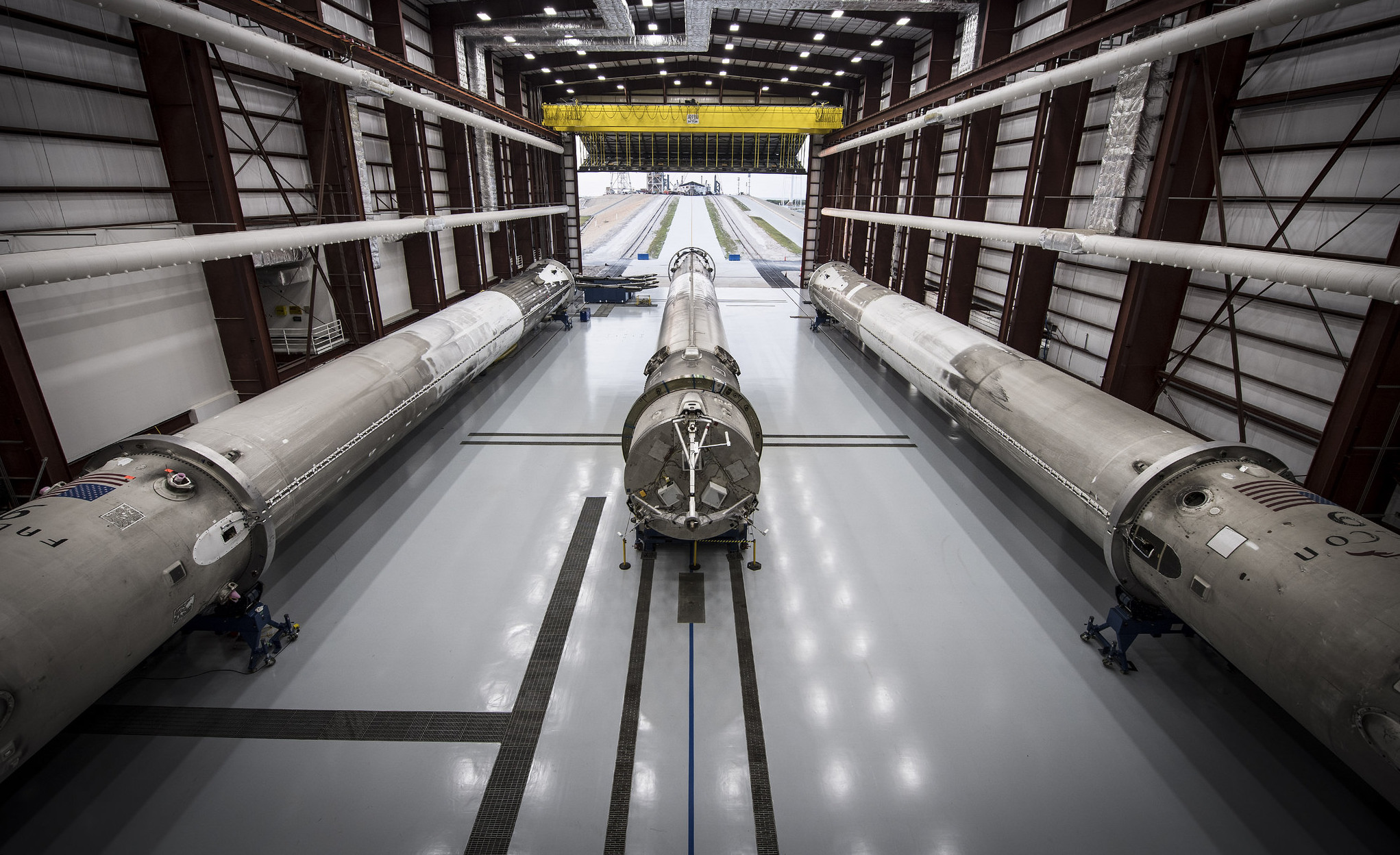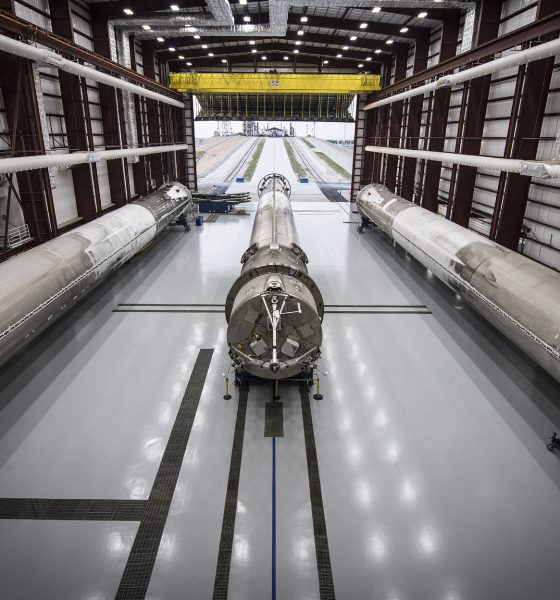

News
SpaceX’s planned refurbishment facility briefly catches fire at Cape Canaveral
Per several sources, a small fire at a planned SpaceX refurbishment facility in Cape Canaveral was put out Sunday evening.
Located inside Port Canaveral, the building suffered a minor amount of water damage and a moderate amount of damage to the roof, where the fire began. The cause of the fire is thus far unclear. More importantly, no injuries were caused by the fire and the building was said by SpaceX employees to have been empty of any valuable hardware.
@BrevardSheriff says small fire at @NASAKennedy @SpaceX building is out. No injuries. Already doing repairs.
— K Reuschle (@KReuschle) July 16, 2017
No SpaceX workers on site at time of fire; building said to be empty, no hardware; water damage reported, roof damage; cause not yet known
— William Harwood (@cbs_spacenews) July 17, 2017
Used as a facility for Astrotech Corporation’s SpaceHab module, which was launched more than 20 times aboard the Space Shuttle, the building was leased by SpaceX approximately a year ago. In addition to the actual SpaceHab facility, the lease included a total of four acres of land expected to be utilized for SpaceX’s program of reusability.
Earlier this year, SpaceX Senior Director of Launch Operations Ricky Lim discussed the company’s excitement over the new facility at a March meeting of the Canaveral Port Authority. Once a second hangar is constructed on the parcel of land, the lease will provide SpaceX with an additional 100,000 square feet of facilities that can be used for Falcon 9 first stage refurbishment and storage. Musk has in the past slyly joked about SpaceX effectively running out of space for the recovered boosters, due to the sheer speed at which the company began to successfully and routinely recover them.
May need to increase size of rocket storage hangar
— Elon Musk (@elonmusk) May 6, 2016
Possibly the most intriguing tidbit about the facility from Lim was the implication that its existence would allow SpaceX to undertake all necessary testing and refurbishment of recovered boosters in Florida. This means SpaceX would no longer be required to transport recovered cores from Cape Canaveral to McGregor, Texas, which has so far been the primary method used for testing and refurbishment. It seems highly implausible that SpaceX would ever be able to secure a permit for routine hot-fire testing at a facility literally within the bounds of an active port, and this implies that SpaceX’s refurbishment procedures will soon pivot away from intensive static fire testing of every recovered booster.
There is no current public timeline for the development of the refurbishment facility, but it is certainly a breath of relief to hear that the small fire that occurred earlier this night was extremely minor and is highly unlikely to impact whatever that construction schedule may be.
SpaceX is preparing to begin launches of the rapid reuse-oriented Block 5 of their Falcon 9 in late 2017, and could conduct as many as 12 more launches this year, beginning in mid-August. It is likely that these new facilities are aiming to become operational at the same time as Block 5, as SpaceX’s extremely busy 2017 and 2018 launch manifests will find the company with a considerable fleet of recovered Falcon 9s.

News
Tesla FSD fleet is nearing 7 billion total miles, including 2.5 billion city miles
As can be seen on Tesla’s official FSD webpage, vehicles equipped with the system have now navigated over 6.99 billion miles.

Tesla’s Full Self-Driving (Supervised) fleet is closing in on almost 7 billion total miles driven, as per data posted by the company on its official FSD webpage.
These figures hint at the massive scale of data fueling Tesla’s rapid FSD improvements, which have been quite notable as of late.
FSD mileage milestones
As can be seen on Tesla’s official FSD webpage, vehicles equipped with the system have now navigated over 6.99 billion miles. Tesla owner and avid FSD tester Whole Mars Catalog also shared a screenshot indicating that from the nearly 7 billion miles traveled by the FSD fleet, more than 2.5 billion miles were driven inside cities.
City miles are particularly valuable for complex urban scenarios like unprotected turns, pedestrian interactions, and traffic lights. This is also the difference-maker for FSD, as only complex solutions, such as Waymo’s self-driving taxis, operate similarly on inner-city streets. And even then, incidents such as the San Francisco blackouts have proven challenging for sensor-rich vehicles like Waymos.
Tesla’s data edge
Tesla has a number of advantages in the autonomous vehicle sector, one of which is the size of its fleet and the number of vehicles training FSD on real-world roads. Tesla’s nearly 7 billion FSD miles then allow the company to roll out updates that make its vehicles behave like they are being driven by experienced drivers, even if they are operating on their own.
So notable are Tesla’s improvements to FSD that NVIDIA Director of Robotics Jim Fan, after experiencing FSD v14, noted that the system is the first AI that passes what he described as a “Physical Turing Test.”
“Despite knowing exactly how robot learning works, I still find it magical watching the steering wheel turn by itself. First it feels surreal, next it becomes routine. Then, like the smartphone, taking it away actively hurts. This is how humanity gets rewired and glued to god-like technologies,” Fan wrote in a post on X.
News
Tesla starts showing how FSD will change lives in Europe
Local officials tested the system on narrow country roads and were impressed by FSD’s smooth, human-like driving, with some calling the service a game-changer for everyday life in areas that are far from urban centers.

Tesla has launched Europe’s first public shuttle service using Full Self-Driving (Supervised) in the rural Eifelkreis Bitburg-Prüm region of Germany, demonstrating how the technology can restore independence and mobility for people who struggle with limited transport options.
Local officials tested the system on narrow country roads and were impressed by FSD’s smooth, human-like driving, with some calling the service a game-changer for everyday life in areas that are far from urban centers.
Officials see real impact on rural residents
Arzfeld Mayor Johannes Kuhl and District Administrator Andreas Kruppert personally tested the Tesla shuttle service. This allowed them to see just how well FSD navigated winding lanes and rural roads confidently. Kruppert said, “Autonomous driving sounds like science fiction to many, but we simply see here that it works totally well in rural regions too.” Kuhl, for his part, also noted that FSD “feels like a very experienced driver.”
The pilot complements the area’s “Citizen Bus” program, which provides on-demand rides for elderly residents who can no longer drive themselves. Tesla Europe shared a video of a demonstration of the service, highlighting how FSD gives people their freedom back, even in places where public transport is not as prevalent.
What the Ministry for Economic Affairs and Transport says
Rhineland-Palatinate’s Minister Daniela Schmitt supported the project, praising the collaboration that made this “first of its kind in Europe” possible. As per the ministry, the rural rollout for the service shows FSD’s potential beyond major cities, and it delivers tangible benefits like grocery runs, doctor visits, and social connections for isolated residents.
“Reliable and flexible mobility is especially vital in rural areas. With the launch of a shuttle service using self-driving vehicles (FSD supervised) by Tesla in the Eifelkreis Bitburg-Prüm, an innovative pilot project is now getting underway that complements local community bus services. It is the first project of its kind in Europe.
“The result is a real gain for rural mobility: greater accessibility, more flexibility and tangible benefits for everyday life. A strong signal for innovation, cooperation and future-oriented mobility beyond urban centers,” the ministry wrote in a LinkedIn post.
News
Tesla China quietly posts Robotaxi-related job listing
Tesla China is currently seeking a Low Voltage Electrical Engineer to work on circuit board design for the company’s autonomous vehicles.

Tesla has posted a new job listing in Shanghai explicitly tied to its Robotaxi program, fueling speculation that the company is preparing to launch its dedicated autonomous ride-hailing service in China.
As noted in the listing, Tesla China is currently seeking a Low Voltage Electrical Engineer to work on circuit board design for the company’s autonomous vehicles.
Robotaxi-specific role
The listing, which was shared on social media platform X by industry watcher @tslaming, suggested that Tesla China is looking to fill the role urgently. The job listing itself specifically mentions that the person hired for the role will be working on the Low Voltage Hardware team, which would design the circuit boards that would serve as the nervous system of the Robotaxi.
Key tasks for the role, as indicated in the job listing, include collaboration with PCB layout, firmware, mechanical, program management, and validation teams, among other responsibilities. The role is based in Shanghai.
China Robotaxi launch
China represents a massive potential market for robotaxis, with its dense urban centers and supportive policies in select cities. Tesla has limited permission to roll out FSD in the country, though despite this, its vehicles have been hailed as among the best in the market when it comes to autonomous features. So far, at least, it appears that China supports Tesla’s FSD and Robotaxi rollout.
This was hinted at in November, when Tesla brought the Cybercab to the 8th China International Import Expo (CIIE) in Shanghai, marking the first time that the autonomous two-seater was brought to the Asia-Pacific region. The vehicle, despite not having a release date in China, received a significant amount of interest among the event’s attendees.








